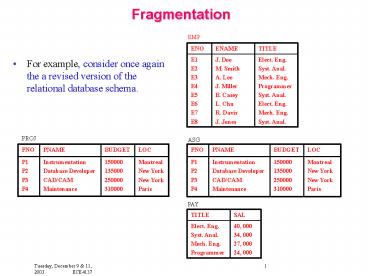Fragmentation - PowerPoint PPT Presentation
1 / 13
Title:
Fragmentation
Description:
B. Casey. L. Chu. R. Davis. J. Jones. E1. E2. E3. E4. E5 ... CAD/CAM. Maintenance. P3. P4. LOC. BUDGET. PNAME. PNO. PROJ1. Montreal. New York. 150000. 135000 ... – PowerPoint PPT presentation
Number of Views:80
Avg rating:3.0/5.0
Title: Fragmentation
1
Fragmentation
EMP
- For example, consider once again the a revised
version of the relational database schema.
PROJ
ASG
PAY
2
Fragmentation
PROJ1
- Thus
- PROJ1 sBUDGET lt 200000 (PROJ)
PROJ2
- And
- PROJ2 sBUDGET gt 200000 (PROJ)
3
Derived Horizontal Fragmentation
- In some cases, the horizontal fragmentation of a
relation can not be based on a property of its
own attributes, but is derived from the
horizontal fragmentation of another relation.
SUPPLIER
SUPPLY
- It is meaningful to partition one of the above
relations so that a fragment contains the tuples
of suppliers in a given city. - However city is not an attribute of the SUPPLY
relaiton, it is an attribute of the SUPPLIER
relation. - Therefore, we need a semi-join operation in order
to combine determine the tuples of SUPPLY which
correspond to the suppliers in a given city. - Thus to find the tuples of SUPPLY which refers to
suppliers in San Francisco, we write - SUPPLY SJSNUM SNUM (sCITY San Francisco
(SUPPLIER))
4
Derived Horizontal Fragmentation
- Similarly consider the primary fragmentation on
PAY through PAY1 sSAL lt 30000 (PAY) and PAY2
sSAL gt 30000 (PAY)
EMP
PAY1
PAY2
5
Derived Horizontal Fragmentation
- Thus EMP1 EMP ? (sSAL lt 30000 (PAY)) and EMP1
EMP ? (sSAL gt 30000 (PAY)
EMP
PAY1
?
?
PAY2
EMP2
EMP1
6
Derived Horizontal Fragmentation
- Some applications involve a join of two or more
relations. If the relations are stored at
different locations, there may be significant
overhead in processing the join. - In such cases it may be appropriate to ensure
that the relations, or fragments of relations,
are at the same location. We can achieve this
using derived fragmentation
Staff
PropertyForRent
7
Derived Tables P1, P2, P3
P1t
P2
P3
8
Derived Horizontal Fragmentation
- We may have an application that joins the Staff
and PropertyForRent relations together. - It is assumed that the Staff relation is
fragmented horizontally and they are stored
locally. - S3sbranchNo B003(Staff)
- S4sbranchNo B005(Staff)
- S5sbranchNo B007(Staff)
- Also, it is assumed that PG14 is currently
managed by SG14 at B003. - It would be useful to store the property using
the same fragmentation strategy. Thus - Pi PropertyForRent? Si, where 3ltilt5
- This will give three relations
9
Mixed Or Hybrid Fragmentation
- In some cases a simple horizontal or vertical
fragmentation of a database schema will not be
sufficient to satisfy the requirements of user
applications. - In this case a vertical fragmentation is followed
by a horizontal or vice versa, producing a tree
structured partitioning of the global relations.
R
H
H
R1
R2
V
V
V
V
V
R11
R12
R21
R22
R23
10
Reconstruction of Hybrid Relation
- To reconstruct the original global relations, one
starts at the leaves of the partitioning tree and
moves upward by performing joins and unions.
?
H
H
?
?
V
V
V
V
V
R11
R12
R21
R22
R23
11
Example of Hybrid Relation
- Consider a global relation EMP(EMPNUM, NAME, SAL,
TAX, MGRNUM, DEPTNUM). - The following is a mixed fragmentation, which is
obtained by applying vertical fragmentation
followed by horizontal fragmentation
- EMP1 sDEPTNUM lt 10 (?EMPNUM, NAME, MGRNUM,
DEPTNUM (EMP)) - EMP2 s10 ltDEPTNUM lt 20 (?EMPNUM, NAME, MGRNUM,
DEPTNUM (EMP)) - EMP3 sDEPTNUM gt 20 (?EMPNUM, NAME, MGRNUM,
DEPTNUM (EMP)) - EMP4 ?EMPNUM, NAME, SAL TAX (EMP))
EMP
V
V
EMP3
H
H
H
EMP1
EMP2
EMP3
12
Allocation Problem
- Consider a set of fragments F F1, F2, F3, . .
. , Fn) and a network consisting of sites S
S1, S2, S3, . . . , Sn on which a set of
applications Q q1, q2, q3, . . . , qn are
running. - The allocation problem involves finding the
optimal distribution of F to S. - What is Optimality?
- This is defined with respect to two measures
- Minimal Cost the cost function consists of the
costs of - Storing each Fi at site Sj
- Querying Fi at site Sj,
- Updating Fi at all sites where it is stored,
- Data communication.
- Performance
- minimizing the response time and to
- maximize the system throughput at each site.
13
Total Cost Function
- The total cost function consists of two
components (i) query processing and (ii)
storage. - Thus it can be expressed as under

